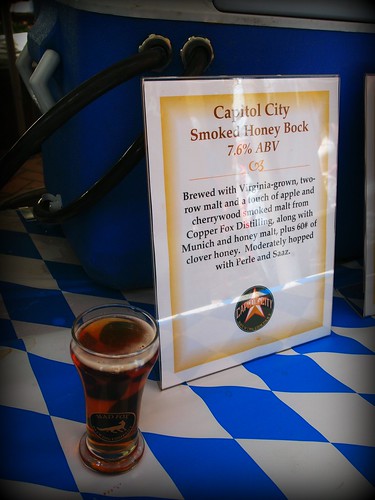On the second day of American Mild Month, last Saturday, what did I do? I went to a Spring Bock Festival, held outdoors at Mad Fox Brewing Company, a brewpub in Falls Church, Virginia (a town only a few miles outside of Washington, D.C.).
What is bock?
Bock beer might not be the antithesis of Mild Ale, but it's certainly not similar. Mild Ale is, of course, an ale, and of low alcohol. Bock is a lager, and high in alcohol.But, oh, what splendid things well-made bocks can be! Dark red-brown (not stout-black), rich, alcohol-warming, malt-luscious, and anywhere from 6 to 7% alcohol-by-volume; and, in the case of maibocks (or 'heller bocks'): deep golden-malty, drier than a 'standard' bock, and noble-hoppy.
Doppelbocks are stronger yet, by convention, over 7% alcohol-by-volume, dark brown-red and (not cloyingly) malty-sweet, but some examples can reach 13%.
More 'craft' bocks?
Attending the festival were thirty-six breweries bringing seventy-two beers. Of those beers, twenty-two were bock beers. It's refreshing (pun intended) to find more 'craft' breweries brewing lagers in this age of hyper-hoppy ales.All but one of these breweries were from the local area: twenty-four were from Virginia, five from Maryland, two from Washington, D.C., three from Pennsylvania, and one from Delaware. The outlier was from Bavaria, in Germany: no personal representative, but two bock biers.
Smoked bock?
Three of the local bocks were made with reasonable percentages of smoked malt. This didn't smack so much of stylistic misinterpretation —such as the assumption by many 'craft brewers' that Scotch Ales must be, ipso facto, peat-smoked— but, rather, as part and parcel of the American 'craft' need to tinker. A 'new' sub-genre?
Cask-conditioned bock?
One bock that afternoon was served cask-conditioned. I wondered, "Why?"Cask-conditioning an ale can bring an unfettered freshness and clarity of flavor to an ale. (Not all ales benefit, however, and that's a story for another time.) Cask-conditioning a lager, such as a bock, on the other hand, does it few favors.
When a properly lagered beer is re-primed with fresh lager yeast in a cask, off-flavors such as sulfur, green apple, and butteriness —that lagering (extended cold storage) had lessened or removed— are reintroduced into the beer. Of course, an ale yeast could be used for priming, instead of a lager yeast. Created then is some sort of hybrid mess, confusing the flavor and nature of the beer.
A much better practice is racking (transferring) already-carbonated lager straight from a maturation tank into a keg. This is called kellerbier or zwickelbier. And if that lager were racked instead into a cask and served? It still wouldn't be a cask-conditioned lager, but simply a lager served from a cask.
The ill-suited cask-conditioned bock in question had also been infused with peppers, cinnamon, and cloves. Again, why? This will not be, I hope, a new sub-genre.
A good day for bock
Bill Madden, president/brewmaster of Mad Fox, has been organizing beer festivals since the mid-1990s, when he was the executive brewer for another area brewpub, Capitol City Brewing. That experience showed.
Brewers and brewery representatives were present. Brewery tables were organized alphabetically, making beers easy to locate. And all with the cooperation of the weather: 79 °F, under mostly sunny skies, with a mild (there you go!) breeze. Seamless enjoyment.
More 'craft' lagers, please!
-----more-----
- For more from YFGF:
- Follow on Twitter: @Cizauskas.
- Like on Facebook: YoursForGoodFermentables.
- Follow on Flickr: Cizauskas.











No comments:
Post a Comment
Comment here ...